"The Eighty Years' War, or Dutch War of Independence, (1568–1648) began as a revolt of the Seventeen Provinces against Philip II of Spain, the sovereign of the Habsburg Netherlands.The images below are essentially a random sampling from a suite of more than 150 engraved prints depicting events of the 80 Years War (or 'Dutch Revolt') made by the Hogenberg family over a forty year period.
After the initial stages Philip II deployed his armies and regained control over most of the rebelling provinces. However, under the leadership of the exiled William of Orange the northern provinces continued their resistance and managed to oust the Spanish armies, and established the republic of the Seven United Netherlands.
The subsequent war between the Spanish empire and the Republic continued, although the heartland of the Republic was no longer threatened. The war ended in 1648 with the Peace of Munster when the Dutch Republic was recognised as an independent country." [W]
"The Eighty Years War was far more than a merely regional event and its last three decades coincided with the Thirty Years War. It was also entwined with the Religious Wars in France and dynastic disputes in England that were partly fought out on Netherlandish battlegrounds. The third sub-series of the Geschichtsblätter [history sheets], for example, depicts events of the French Religious Wars (1559–1573) while the fourth series shows events in France as well as in England." [source]

Schlacht bei Austruweel (c 1567)
Battle of Austruweel [Oosterweel] (Antwerp)
Battle of Austruweel [Oosterweel] (Antwerp)
"The Battle of Oosterweel took place on March 13, 1567, and is traditionally seen as the beginning of the Eighty Years' War. The battle was fought near the village of Oosterweel, north of Antwerp*. A Spanish professional army under General Beauvoir defeated an army of radical Calvinists rebels under Jan de Marnix. The prisoners were considered rebels and all were killed. Some 700-800 Protestants died. William the Silent, the Burggraaf of Antwerp, did not allow the Protestants of the city to come to their aid, because he, as lord of the city, was bound by oath to support the Spanish king."
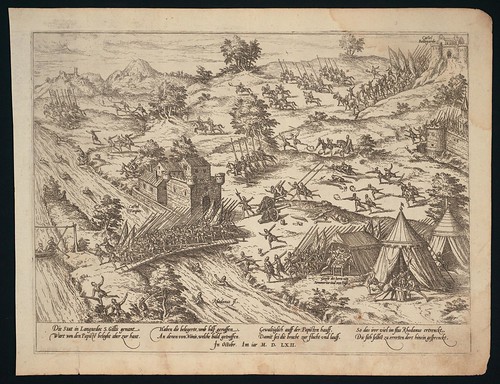
Entsetzung von St. Gilles durch die Protestanten von Nimes (c 1562)
Relief of St Gilles (town in Languedoc, France*)
by the Protestant reinforcements from Nîmes
Relief of St Gilles (town in Languedoc, France*)
by the Protestant reinforcements from Nîmes

Verkundung des Waffenstillstands in Antwerpen (c 1609)

Anschlag des Pierre Chastel auf Heinrich IV (c 1594)
Pierre* Chastel's Attack on Henri IV
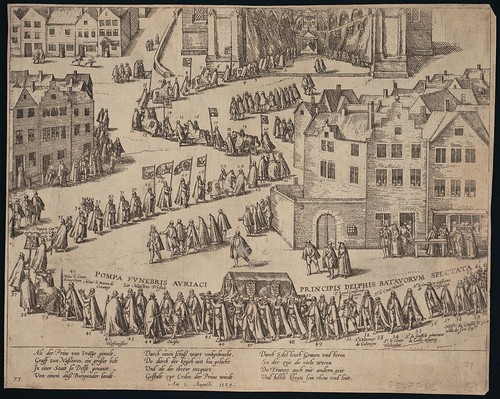
Leichenzug Wilhelms von Oranien in Delft (c 1584)
Funeral Cortège for William of Orange at Delft
Funeral Cortège for William of Orange at Delft
"William of Orange, leader of the Dutch Revolt against Spain, was assassinated by Balthasar Gerardts in Delft on 10 July 1584. The Prince's funeral took place in Delft on 3 August. A stately procession bore the 'Father of the Nation' to his tomb in the Nieuwe Kerk." [source]
{also: another extraordinary engraving of the procession at Wikimedia}

Schleifung des Castells zu Antwerpen (c 1577)
Slighting of the Castle of Antwerp {?}
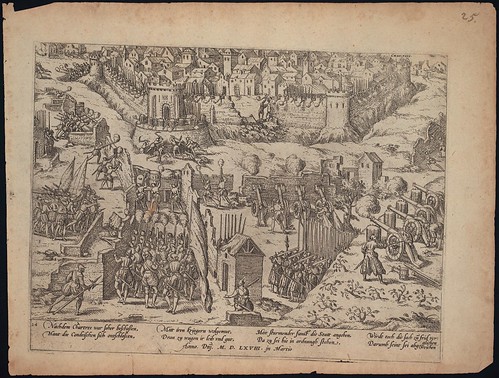
Belagerung und Vergleich von Chartres (c 1568)
Siege (and Accord) of Chartres [in France]
"The Siege of Chartres in February to March 1568 was the pivotal event which ended the Second War of Religion, an episode of the French Wars of Religion.
The Huguenot army besieged the town at the end of February. The Prince of Condé had five battering cannons and four light culverins.[3] Part of the army acted as block and the rest, about 9,000 men, encircled the town and used their nine guns to breach the north wall. The Huguenots assaulted the town on March 7, but the Royal garrison of Nicolas des Essars, assisted by inhabitants defended stoutly. The assault was repelled and the breach sealed off.
Following the lifted siege, the Peace of Longjumeau was signed, on March 23." [source]

Arnheim - Knodsenburg - Nijmwegen (c 1600)
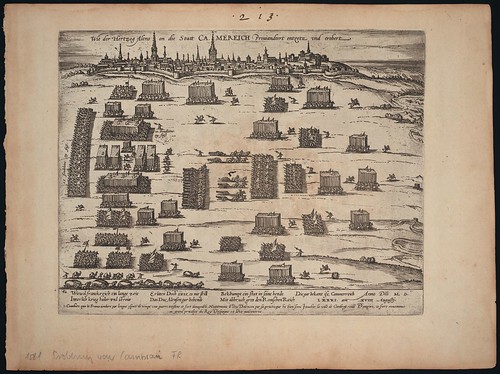
Wie der Hertzog Alenson die Statt Camereich
Proviandeert entzetz und erobert (c 1581)
The relief army under the Duke of Alençon enters (conquers)
the city of Cambrai in Northern France (?) [Duke's bio]
Proviandeert entzetz und erobert (c 1581)
The relief army under the Duke of Alençon enters (conquers)
the city of Cambrai in Northern France (?) [Duke's bio]
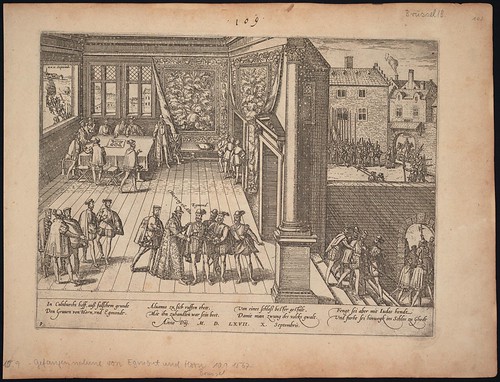
Gefangennahme von Egmont und Hoorn (c 1567)
Capture of Egmont and Hoorn
Capture of Egmont and Hoorn
The Duke of Alba (Alva), carried out the brutal repression of Protestants in the Netherlands from 1567 to 1573 at the behest of Spanish King Philip II. The Duke ordered the arrest, torture at the hands of the Inquisition and subsequent beheading of the two most important noblemen in the country, Counts Egmont and Hoorn. They became martyrs and figureheads of the resistance.
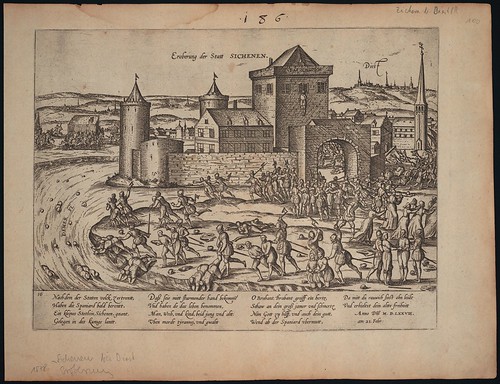
Eroberung von Sichenen (Sichem) bei Diest (c. 1578)
Conquest of Zichem, near Diest in Flemish Brabant*
Conquest of Zichem, near Diest in Flemish Brabant*
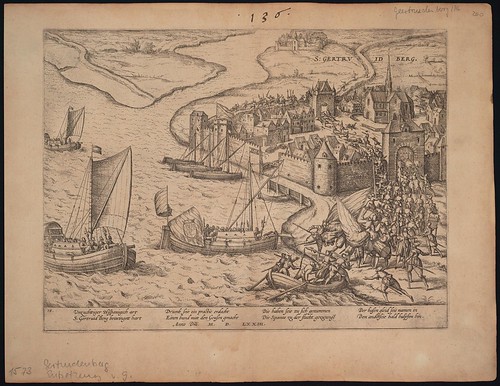
Geertruidenberg durch die Geusen entsetzt (c 1573)
Geertruidenberg (North Brabant town*) relieved by
the Geuzen (rebel Calvinist sea 'beggars' or pirates)
the Geuzen (rebel Calvinist sea 'beggars' or pirates)

Niederlage des Martin Schenk bei Amerongen nahe Utrecht (c 1585)
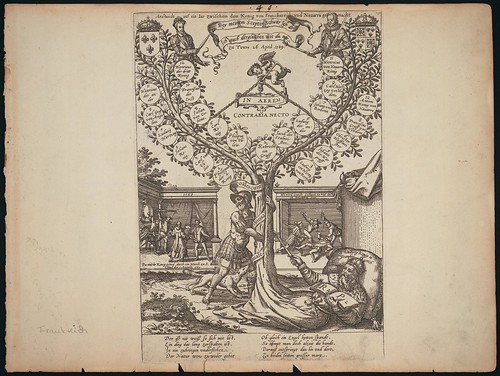
Stammbaum Ludwigs IX. Zum Anstand vom 26 April, 1589
Family Tree of French King Louis IX (13th c.)
The two branches atop the tree refers to the truce agreed on 26 April 1589 between King Henri III of France and the Huguenot Henry of Navarre, so that their forces could be combined against the Catholic League. The print also shows the assassination of Henri III in August of 1589 by a Dominican friar. Henry of Navarre succeeded as Henri IV, King of France and Navarre.
The highly detailed engravings were produced by Franz Hogenberg and his son Abraham between 1570 and 1610 in Cologne. The elder engraver/publisher most famously contributed to the enormous Braun 'Cities of the Earth' book.
- The Hogenberg prints of the 80 Years War are available among the Digital Collections of the Princeton University Library. The vast majority of text on the prints is in German, but there's a smattering of French and Dutch as well.
- Wikimedia has a selection of images pertaining to the 80 Years War including some of the Hogenberg suite from Rotterdam's Museum Boijmans Van Beuningen.
- Google's cache of a detailed 80 Years War timeline.
- Some biographic background to the Hogenbergs.
- Thanks very much to Nina Stössingert for the help with translations.
- Via Archivalia.
Tidak ada komentar:
Posting Komentar